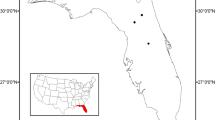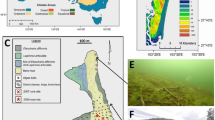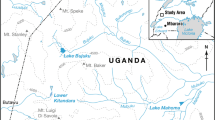Abstract
Wetland carbon storage is an important and environmentally sensitive ecosystem service. Carbon burial in the floodplain lakes of the Pantanal (tropical South America) appears to have varied during the late Quaternary, but several paleolimnological studies have recorded unusually high sediment organic carbon content from ~ 7.3 to 6.0 cal kyr BP in lakes connected to the Upper Paraguay River. We conducted a multi-indicator (phytoliths, sponge spicules, and geochemistry) study of a sediment core from Lake Cáceres (Bolivia), and found evidence for enhanced organic carbon burial during the middle Holocene that provides insights into the flooding history of the Upper Paraguay River. δ13Corg and C/N data suggest that organic matter deposited at that time in Lake Cáceres was from macrophytes. Similar datasets from three other floodplain lakes are consistent with this finding. We suggest that enhanced carbon burial occurred when lake levels declined under relatively dry climate conditions, which increased the littoral area at the expense of open water and captured floating macrophyte islands. This study sheds new light on hydroclimate controls on carbon cycling in the Pantanal wetlands, and improves interpretations of geochemical measures on bulk organic matter in floodplain lake cores.









Similar content being viewed by others
References
Assine ML, Merino ER, Pupim FN, Warren LV, Guerreiro RL, McGlue MM (2015) Geology and geomorphology of the Pantanal Basin. In: Bergier I, Assine ML (eds) Dynamics of the Pantanal wetland in South America. The Handbook of Environmental Chemistry, Springer, Cham, pp 23–50. https://doi.org/10.1007/698_2015_349
Batista TCA, Volkmer-Ribeiro C (2002) Comunidades de esponjas do curso superior dos rios Paraná (Goiás) e Paraguai (Mato Grosso), Brasil, com redescrição de Oncosclera schubarti (Bonetto & Ezcurra de Drago). Rev Bras Zool 19:123–136. https://doi.org/10.1590/S0101-81752002000100010
Batista TCA, Volkmer-Ribeiro C, Darwich A, Alves LF (2003) Freshwater sponges as indicators of floodplain lake environments and of river rocky bottoms in Central Amazonia. Amazoniana 17:525–549
Bazoberry AQ (2005) Canal fluvial nuevo Puerto Suárez. Plural, La Paz
Bergier I, Salis SM, Miranda CHB, Ortega H, Luengo CA (2012) Biofuel production from water hyacinth in the Pantanal wetland. Ecohydrol Hydrobiol 12:77–84. https://doi.org/10.2478/v10104-011-0041-4
Bergier I, Silva APS, Monteiro H, Guérin F, Macedo HA, Silva A, Krusche A, Sawakuchi HO, Bastviken D (2015) Methane and carbon dioxide dynamics in the paraguay river floodplain (Pantanal) in episodic anoxia events. In: Bergier I, Assine ML (eds) Dynamics of the Pantanal wetland in South America. The Handbook of Environmental Chemistry, Springer, Cham, pp 163–178. https://doi.org/10.1007/698_2015_353
Bertaux J, Sondag F, Santos R, Soubies F, Casse C, Plagnes V, Le Cornec F, Seidel F (2002) Palaeoclimatic record of speleothems in a tropical region: study of laminated sequences from a Holocene stalagmite in central-west Brazil. Quat Int 89:3–16. https://doi.org/10.1016/S1040-6182(01)00077-5
Bezerra MAO, Mozeto AA (2008) Deposição de carbono orgânico na planície de inundação do Rio Paraguai durante o Holoceno médio. Oecol Bras 12:155–171
Bezerra MAO, Mozeto AA, Oliveira PE, Volkmer-Ribeiro C, Rodrigues VV, Aravena R (2019) Late Pleistocene/Holocene environmental history of the Southern Brazilian Pantanal wetlands. Oecol Aust 23:712–729. https://doi.org/10.4257/oeco.2019.2304.02
Blaauw M, Christen JA (2011) Flexible paleoclimate age-depth models using an autoregressive gamma process. Bayesian Anal 6:457–474. https://doi.org/10.1214/11-BA618
Bonetto AA, Ezcurra de Drago ID (1966) Nuevos aportes al conocimiento de las esponjas Argentinas. Physis 26:129–140
Bonetto AA, Ezcurra de Drago I (1967) Esponjas del noreste Argentino. Acta Zool Lillo 23:331–348
Bonetto AA, Ezcurra de Drago I (1970) Esponjas de los afluentes del Alto Parana em la província de Misiones. Acta Zool Lilloana 28:37–68
Bonetto AA, Ezcurra de Drago I (1973) Las esponjas del gênero Trochospongilla Vejdovsky en aguas argentinas. Physis 32:13–18
Brasil (1982) Ministério de Minas e Energia. Secretaria-Geral. Projeto RADAMBRASIL. Folha SE.21 Corumbá e parte da Folha SE.20; geologia, geomorfologia, pedologia, vegetação e uso potencial da terra. Rio de Janeiro, Rio de Janeiro, v.27. 448p.
Bremond L, Alexandre A, Peyron O, Guiot J (2005) Grass water stress estimated from phytoliths in West Africa. J Biogeogr 32:311–327. https://doi.org/10.1111/j.1365-2699.2004.01162.x
Carey CC, Doubek JP, McClure RP, Hanson P (2018) Oxygen dynamics control the burial of organic carbon in a eutrophic reservoir. Limnol Oceanogr Lett 3:293–301. https://doi.org/10.1002/lol2.10057
Cohen A, McGlue MM, Ellis GS, Zani H, Swarzenski PW, Assine ML, Silva A (2015) Lake formation, characteristics, and evolution in retroarc deposystems: a synthesis of the modern Andean orogen and its associated basins. In: DeCelles PG, Ducea MN, Carrapa B, Kapp PA (eds) Geodynamics of a cordilleran orogenic system: the central Andes of Argentina and Northern Chile, Geological Society of America Memoir, vol 212. pp 309–335. https://doi.org/10.1130/2015.1212(16)
Cole JJ, Prairie YT, Caraco NF, McDowell WH, Tranvik LJ, Striegl RG, Duarte CM, Kortelainen P, Downing JA, Middelburg JJ, Melack J (2007) Plumbing the global carbon cycle: integrating inland waters into the terrestrial carbon budget. Ecosystems 10:171–184. https://doi.org/10.1007/s10021-006-9013-8
Coplen TB, Brand WA, Gehre M, Groning M, Meijer HAJ, Toman B, Verkouteren RM (2006) New guidelines for δ13C measurements. Anal Chem 78:2439–2441. https://doi.org/10.1021/ac052027c
Coutinho BA, Pott VJ, Arrua BA, Aoki C, Pott A (2018) Ecological succession of aquatic macrophytes on floating meadows in the Pantanal wetland. Braz J Bot 41:65–75. https://doi.org/10.1007/s40415-017-0425-9
Dalmagro HJ, Lathuillière MJ, Hawtrhorne I, Morais DD, Pinto OB Jr, Couto EG, Johnson MS (2018) Carbon biogeochemistry of a flooded Pantanal forest over three annual flood cycles. Biogeochemistry 139:1–18. https://doi.org/10.1007/s10533-018-0450-1
Dalmagro HJ, Arruda PHZ, Vourlitis GL, Lathuillière MJ, Nogueira JS, Couto EG, Johnson MS (2019) Radiative forcing of methane fluxes offsets net carbon dioxide uptake for a tropical flooded forest. Glob Change Biol 25:1967–1981. https://doi.org/10.1111/gcb.14615
Einsele G, Yan J, Hinderer M (2001) Atmospheric carbon burial in modern lake basins and its significance for the global carbon budget. Glob Planet Change 30:167–195. https://doi.org/10.1016/S0921-8181(01)00105-9
Ezcurra De Drago, I (1993) Distribución geográfica de las esponjas argentinas (Porifera: Spongillidae, Potamolepidae y Metaniidae). Relaciones zoogeográficas, vías de poblamiento. In: Boltovkoy A, López YH (eds), Conferencias de Limnología. Instituto de Limnología “Dr. Raúl A. Ringuelet”, La Plata, Buenos Aires, 115–125
Ezcurra de Drago I, Bonetto AA (1969) Algunas características del bentos em los saltos del Rio Uruguay, com especial referencia a la ecologia de los poríferos. Physis XXVIII:359–369
Fellerhoff C, Voss M, Wantzen KM (2003) Stable carbon and nitrogen isotope signatures of decomposing tropical macrophytes. Aquat Ecol 37:361–375. https://doi.org/10.1023/B:AECO.0000007049.25535.12
Frey R (1995) Flora and vegetation of "Las Piedritas" and the margin of Laguna Caceres, Puerto Suarez, Bolivian Pantanal. Bull Torrey Bot Club 122:314–319. https://doi.org/10.2307/2996324
Frisone V, Pisera A, Hajdu E, Preto N, Zorzi F, Zorzin R (2014) Isolated spicules of Demospongiae from Mt. Duello (Eocene, Lessini Mts., northern Italy): preservation, taxonomy, and depositional environment. Facies 60:883–904. https://doi.org/10.1007/s10347-014-0407-3
Garreaud RD, Vuille M, Compagnucci R, Marengo J (2009) Present-day South American climate. Palaeogeogr Palaeoclimatol Palaeoecol 281:180–195. https://doi.org/10.1016/j.palaeo.2007.10.032
Grimm EC (1987) CONISS: a Fortran 77 Program for Stratigraphically Constrained Cluster Analysis by the Method of Incremental Sum of Squares. Comput Geosci 13:13–35. https://doi.org/10.1016/0098-3004(87)90022-7
Hogg AG, Hua Q, Blackwell PG, Niu M, Buck CE, Guilderson TP, Heaton TJ, Palmer JG, Reimer PJ, Reimer RW, Turney CSM, Zimmerman SRH (2013) SHCal13 Southern Hemisphere calibration, 0–50,000 Years cal BP. Radiocarbon 55:1889–1903. https://doi.org/10.2458/azu_js_rc.55.16783
Ivory SJ, McGlue MM, Spera S, Silva A, Bergier I (2019) Vegetation, rainfall, and pulsing hydrology in the Pantanal, the world’s largest tropical wetland. Environ Res Lett 14:124017. https://doi.org/10.1088/1748-9326/ab4ffe
Junk WJ, Bayley PB, Sparks RE (1989) The flood pulse concept in river-floodplain systems. Can Spec Publ Fish Aquat Sci 106:110–127
Junk WJ, An S, Finlayson CM, Gopal B, Kvě M, Stephen A, Mitsch WJ, Robarts RD (2013) Current state of knowledge regarding the world-s wetlands and their future under global climate change: a synthesis. Aquat Sci 75:151–167. https://doi.org/10.1007/s00027-012-0278-z
Junk WJ, Piedade MTF, Lourival R, Wittmann F, Kandus P, Lacerda LD, Bozelli R, Esteves FA, Nunes da Cunha C, Maltchik L, Schöngart J, Schaeffer-Novelli Y, Agostinho AA (2014) Brazilian wetlands: their definition, delineation, and classification for research, sustainable management, and protection. Aquat Conserv 24:5–22. https://doi.org/10.1002/aqc.2386
Kuerten S, Parolin M, Assine M, McGlue MM (2013) Sponge spicules indicate Holocene environmental changes on the Nabileque River floodplain, southern Pantanal, Brazil. J Paleolimnol 49:171–183. https://doi.org/10.1007/s10933-012-9652-z
Lacerda Filho JV, Silva MG, Hardy J (2006) Geologia e recursos minerais do Estado de Mato Grosso do Sul: texto explicativo dos mapas geológico e de recursos minerais do Estado de Mato Grosso do Sul: escala 1:1.000.000. Campo Grande: CPRM-Serviço Geológico do Brasil. 121 p
Lo EL, Silva A, Bergier I, Mcglue MM, Silva BLDP, Silva APS, Pereira LE, Macedo HDA, Assine ML, Silva ERDSD (2017) Spatiotemporal evolution of the margins of Lake Uberaba, Pantanal floodplain (Brazil). Geografia 42:159–173
Lo EL, Mcglue MM, Silva A, Bergier I, Yeager KM, Macedo HÁ, Swallom M, Assine M (2019) Fluvio-lacustrine sedimentary processes and landforms on the distal Paraguay fluvial megafan (Brazil). Geomorphology 342:163–175. https://doi.org/10.1016/j.geomorph.2019.06.001
Madella M, Alexandre A, Ball T (2005) International code for phytolith nomenclature 1.0. Ann Bot (Lond) 96:253–260. https://doi.org/10.1093/aob/mci172
McGlue MM, Silva A, Corradini FA, Zani H, Tree MA, Ellis GE, Parolin M, Swarzenski PW, Cohen AS, Assine ML (2011) Limnogeology in Brazil's “forgotten wilderness”: a synthesis from the large floodplain lakes of the Pantanal. J Paleolimnol 46:273–289. https://doi.org/10.1007/s10933-011-9538-5
McGlue MM, Silva A, Zani H, Corradini FA, Parolin M, Abel EJ, Cohen AS, Assine ML, Ellis GS, Trees MA, Kuerten S, Gradella FS, Rasbold GG (2012) Lacustrine records of Holocene flood pulse dynamics in the Upper Paraguay River watershed (Pantanal wetlands, Brazil). Quat Res 78:285–294. https://doi.org/10.1016/j.yqres.2012.05.015
McGlue MM, Silva A, Assine ML, Stevaux JC, Pupim FN (2015) Paleolimnology in the Pantanal: using lake sediments to track quaternary environmental change in the world’s largest tropical Wetland. In: Bergier I, Assine ML (eds) Dynamics of the Pantanal wetland in South America. The Handbook of Environmental Chemistry, Springer, Cham, pp 51–81. https://doi.org/10.1007/698_2015_350
Metcalfe SE, Whytney BS, Fitzpatrick KA, Mayle F, Loader NJ, Street-Perrot A, Mann DG (2014) Hydrology and climatology at Laguna La Gaiba, lowland Bolivia: complex responses to climatic forcings over the last 25 000 years. J Quat Sci 29:289–300. https://doi.org/10.1002/jqs.2702
Meyers PA (1994) Preservation of source identification of sedimentary organic matter during and after deposition. Chem Geol 144:289–302. https://doi.org/10.1016/0009-2541(94)90059-0
Mitsch W, Gosselink JG (2015) Wetlands. Wiley, New Jersey
Mitsch WJ, Nahlik A, Wolski P, Bernal B, Zhang L, Ramberg L (2010) Tropical wetlands: seasonal hydrologic pulsing, carbon sequestration, and methane emissions. Wetl Ecol Manag 18:573–586. https://doi.org/10.1007/s11273-009-9164-4
Mitsch WJ, Bernal B, Nahlik AM, Mander Ü, Zhang L, Anderson CJ, Jørgensen SE, Brix H (2013) Wetlands, carbon, and climate change. Landsc Ecol 28:583–597. https://doi.org/10.1007/s10980-012-9758-8
Mormul RP, Thomaz SM, Vieira LJS (2013) Richness and composition of macrophyte assemblages in four Amazonian lakes. Acta Sci Biol Sci 35:343–350. https://doi.org/10.4025/actascibiolsci.v35i3.11602
Neue HU, Gaunt JL, Wang ZP, Becker-Heidmann P, Quijano C (1997) Carbon in tropical wetlands. Geoderma 79:163–185. https://doi.org/10.1016/S0016-7061(97)00041-4
Novello VF, Vuille M, Cruz FW, Stríkis NM, Paula MS, Edwards RL, Cheng H, Karmann I, Jaqueto PF, Trindade RIF, Hartmann GA, Moquet JS (2016) Centennial-scale solar forcing of the South American Monsoon System recorded in stalagmites. Sci Rep 6:24762. https://doi.org/10.1038/srep24762
Novello VF, Cruz FW, Vuille M, Stríkis NM, Edwards RL, Cheng H, Emerick S, Saito de Paula M, Li X, Barreto ES, Karmann I, Santos RV (2017) A high-resolution history of the South American monsoon from last glacial maximum to the Holocene. Sci Rep 7:44267. https://doi.org/10.1038/srep44267
Novello VF, Cruz FW, McGlue MM, Wong CI, Ward BM, Vuille M, Santos RA, Jaqueto P, Pessenda LC, Atorre T, Ribeiro LM (2019) Vegetation and environmental changes in tropical South America from the last glacial to the Holocene documented by multiple cave sediment proxies. Earth Planet Sci Lett 524:115717. https://doi.org/10.1016/j.epsl.2019.115717
Oliveira MRF, Melhado AFP, Oda FH, Melo SM, Parolin M, Benedito E (2018) Sponge species composition and habitat use in a small stream within the agricultural landscape in the lower Tietê River basin in southeastern Brazil, with the first record of Corvoheteromeyenia australis (Demospongiae: Spongillidae) in São Paulo state. Northwest J Zool 14:30–36
Parolin M, Volkmer-Ribeiro C, Stevaux JC (2008) Use of spongofacies as a proxy for River-Lake Paleohydrology in quaternary deposits of Central-Western Brazil. Rev Bras Paleontolog 11:187–198. https://doi.org/10.4072/rbp.2008.3.05
Parry WD, Smithson F (1958) Silicification of bulliform cells in grasses. Nature 181:1549–1550. https://doi.org/10.1038/1811549b0
Philbrick CT, Bove CP, Stevens HI (2010) Endemism in neotropical podostemaceae. Ann Mo Bot Gard 97:425–456. https://doi.org/10.3417/2008087
Pinheiro US (2007) Contribuições à taxonomia e biogeografia das Esponjas de águas continentais Brasileiras. (Ph.D. Thesis). Biological sciences (Zoology). Federal University of Rio de Janeiro, 220 p
Pinheiro US, Calheira L (2020) Phylum Porifera. In: Camborenea C, Thorp J (eds) Rogers DC. Freshwater Invertebrates, Academic Press, pp 79–92. https://doi.org/10.1016/B978-0-12-804225-0.00003-4
Pinheiro US, Hajdu E, Caballero ME (2003) Três novos registros de esponjas (Porifera, Demospongiae): para águas continentais do Estado de São Paulo. 498. Boletim do Museu Nacional, Nova Série, Zoologia, pp 1–14
Por FD (1995) The Pantanal of Mato Grosso (Brazil): world’s largest Wetlands. Kluwer Academic, Dordrecht, p 125p. https://doi.org/10.1007/978-94-011-0031-1
Pott A, da Silva JSV (2015) Terrestrial and Aquatic Vegetation Diversity of the Pantanal wetland. In: Bergier I, Assine M (eds) Dynamics of the Pantanal wetland in South America. The Handbook of Environmental Chemistry, Springer, Cham, pp 111–131. https://doi.org/10.1007/698_2015_352
Rasbold GG, McGlue MM, Stevaux JC, Parolin M, Silva A, Bergier I (2019) Sponge spicule and phytolith evidence for Late Quaternary environmental changes in the tropical Pantanal wetlands of western Brazil. Palaeogeogr Palaeoclimatol Palaeoecol 518:119–133. https://doi.org/10.1016/j.palaeo.2019.01.015
Rasbold GG, Stevaux JC, Parolin M, Leli IT, Luz LD, Brito HD (2020) Phytoliths indicate environmental changes correlated with facies analysis in a paleo island-lake, Upper Paraná River. Braz J S Am Earth Sci 99:102513. https://doi.org/10.1016/j.jsames.2020.102513
Sangster G, Parry WD (1969) Some factors in relation to bulliform cell silicification in the grass leaf. Ann Bot 33:315–323. https://doi.org/10.1093/oxfordjournals.aob.a084285
Schnurrenberger D, Russell JM, Kelts K (2003) Classification of lacustrine sediments based on sedimentary components. J Paleolimnol 29:141–154. https://doi.org/10.1023/A:1023270324800
Shindell DT, Walter BP, Faluvegi G (2004) Impacts of climate change on methane emissions from wetlands. Geophys Res Lett 21:L21202. https://doi.org/10.1029/2004GL021009
Sifeddine A, Martin L, Turcq B, Volkmer-Ribeiro C, Soubiès F, Cordeiro RC, Suguio K (2001) Variations of the Amazonian rainforest environment: a sedimentological record covering 30,000 years. Palaeogeogr Palaeoclimatol Palaeoecol 168:221–235. https://doi.org/10.1016/S0031-0182(00)00256-X
Sobek S, Scherber C, Steffan-Dewenter I, Tscharntke T (2009) Sapling herbivory, invertebrate herbivores and predators across a natural tree diversity gradient in Germany’s largest connected deciduous forest. Oecologia 160:279–288. https://doi.org/10.1007/s00442-009-1304-2
Stríkis NM, Cruz FW, Cheng H, Karman I, Edwards L, Vuille M, Wang X, Paula MS, Novello VF, Auler AS (2011) Abrupt variations in South American monsoon rainfall during the Holocene based on a speleothem record from central-eastern Brazil. Geology 39:1075–1078. https://doi.org/10.1130/G32098.1
Tavares MCM, Volkmer-Ribeiro C, De Rosa-Barbosa R (2003) Primeiro registro de Corvoheteromeyenia australis (Bonetto & Ezcurra de Drago) para o Brasil com chave taxonômica para os poríferos do Parque Estadual Delta do Jacuí, Rio Grande do Sul, Brasil. Rev Bras Zool 20:169–182. https://doi.org/10.1590/S0101-81752003000200001
Tavares-Frigo MC, Volkmer-Ribeiro C, Oliveira AEZ, Machado VS (2015) Freshwater sponges from the Pampa Biome, Brazil, with description of a new species of Oncosclera. Neotrop Biol Conserv 10:110–122. https://doi.org/10.4013/nbc.2015.103.01
Tockner K, Pennetzdorfer D, Reiner K, Schimier F, Ward JV (1999) Hydrological connectivity, and the exchange of organic matter and nutrients in a dynamic river-floodplain system (Danube, Austria). Freshw Biol 41:521–535. https://doi.org/10.1046/j.1365-2427.1999.00399.x
Volkmer-Ribeiro C (1985) Esponjas de Água doce. Manuais Técnicos para a Preparação de Coleções Zoológicas 3:1–6
Volkmer-Ribeiro C (1999) Porifera. In: Ismael D, Valenti WC, Matsumura-Tundisi T, Rocha O (eds) Biodiversidade do Estado de São Paulo: Síntese do Conhecimento ao Final do Século XX. Invertebrados de água doce, FAPESP, São Paulo, pp 1–9
Volkmer-Ribeiro C, De Rosa-Barbosa R (1985) Redescription of the Freshwater Sponges Trochospongilla repens (Hinde, 1888) and Trochospongilla amazonica (Weltner, 1895) with an account of the South American species of Trochospongilla (Porifera, Spongillidae). Iheringia Sér Zool 65:77–93
Volkmer-Ribeiro C, Hatanaka T (1991) Nota científica: composição específica e substrato da espongofauna (Porifera) no lago da Usina Hidroelétrica- Tucurui, Pará, Brasil. Iheringia Sér Zool 71:177–178
Volkmer-Ribeiro C, Pauls SM (2000) Esponjas de agua Dulce (Porifera, Demospongiae) de Venezuela. Acta Biol Venez 20:1–28
Volkmer-Ribeiro C, Grosser KM, Rosa-Barbosa R, Pauls SM (1975) Primeiro relato da ocorrência de Espongilideos (Porifera) na bacia do Guaíba, Estado do Rio Grande do Sul. Iheringia Sér Zool 46:33–49
Volkmer-Ribeiro C, Correia MF, Brenha SLA, Mendonça MA (1999) Freshwater sponges from a Neotropical sand dune area. Mem-Qld Mus 44:643–649
Vuille M, Burns JS, Taylor BL, Cruz FW, Bird BW, Abbott MB, Kanner LC, Cheng H, Novello VF (2012) A review of the South American monsoon history as recorded in stable isotopic proxies over the past two millennia. Clim Past 8:1309–1321. https://doi.org/10.5194/cpd-8-637-2012
Wetzel RG (1992) Gradient-dominated ecosystems: sources and regulatory functions of dissolved organic matter in freshwater ecosystems. Hydrobiologia 229:181–198. https://doi.org/10.1007/BF00007000
Wilding LP, Drees LR (1968) Distribution and implications of sponge spicules in surficial deposits in Ohio. Ohio J Sci 68:92–99
Acknowledgements
The first author thanks the Coordination for the Improvement of High Education Personal (CAPES) for a scholarship (PROEX/CAPES) and the National Council for Scientific and Technological Development for an international scholarship (CNPq 204880/2018-1). We acknowledge the National Council for Scientific and Technological Development for financial support (CNPq 431253/2018-8). We acknowledge the support of the Brazilian Agricultural Research Corporation, Embrapa (03.17.00.047) and the National Geographic Society (#9797-15). This study was financed in part by the Coordenação de Aperfeiçoamento de Pessoal de Nível Superior—Brasil (CAPES)—Finance Code 001. This study also received financial support from the Fundação Universidade Federal de Mato Grosso do Sul – UFMS/MEC – Brazil. We are grateful to Armada Boliviana de Puerto Quijarro for authorization to collect samples. We are grateful to two reviewers and the associate editor for comments that improved this paper.
Author information
Authors and Affiliations
Corresponding author
Additional information
Publisher's Note
Springer Nature remains neutral with regard to jurisdictional claims in published maps and institutional affiliations.
Electronic supplementary material
Below is the link to the electronic supplementary material.
Rights and permissions
About this article
Cite this article
Rasbold, G.G., McGlue, M.M., Stevaux, J.C. et al. Enhanced middle Holocene organic carbon burial in tropical floodplain lakes of the Pantanal (South America). J Paleolimnol 65, 181–199 (2021). https://doi.org/10.1007/s10933-020-00159-5
Received:
Accepted:
Published:
Issue Date:
DOI: https://doi.org/10.1007/s10933-020-00159-5




